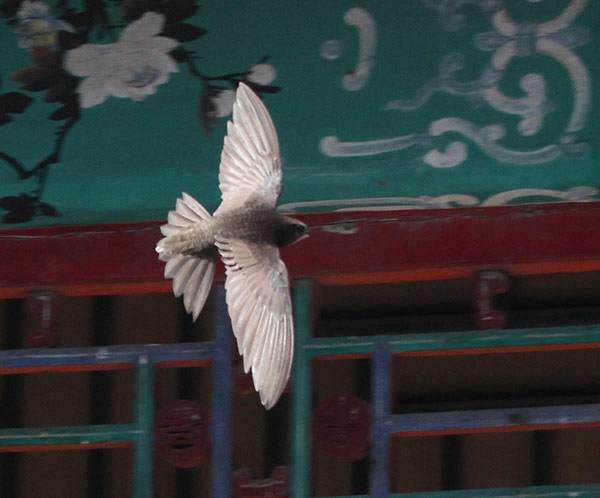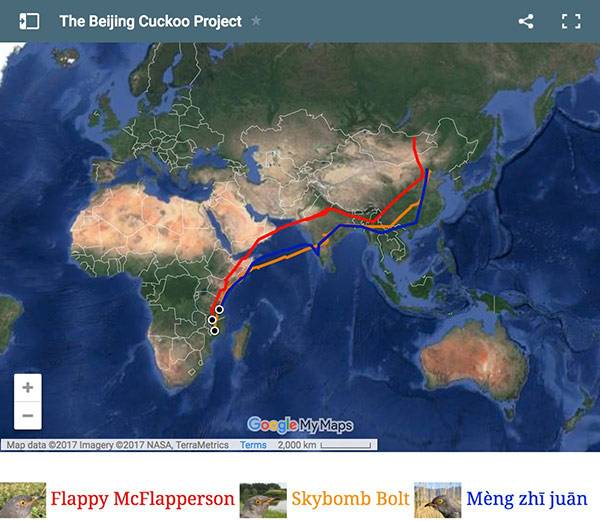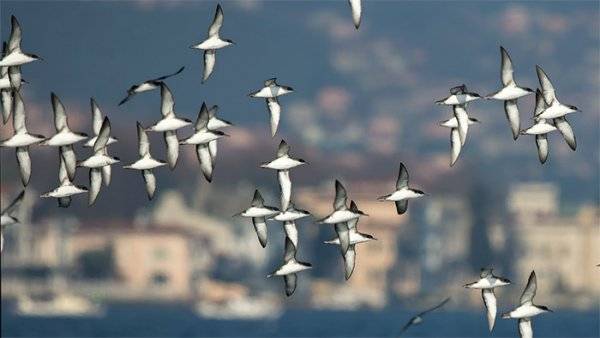Guest blog by Terry Townshend

WU Lan, one of China Birdwatching Society’s volunteers trained by BTO’s Chris Hewson.
The Beijing Swift
The Common Swift (Apus apus pekinensis) is a much-loved bird in China and has been synonymous with the Chinese capital since 1417 when it began to breed in the city’s gatehouses. For centuries these aerial masters would arrive each April and depart at the end of July but to where remained a mystery. That all changed when, as part of an ongoing project by the China Birdwatching Society, thirty-one Beijing Swifts (Apus apus pekinensis) were fitted with light-level geolocators at the Summer Palace in Beijing in May 2014. The devices are too light to include transmitters, so access to the data requires the birds to be re-caught and the data downloaded, after which it is analysed using special software. The following year, after an agonising wait, thirteen of the thirty-one were recaptured at the Summer Palace and their data downloaded. The results were spectacular. The data showed that, when they leave the capital in late July, Beijing Swifts initially head west-northwest into Mongolia, from where they pass north of the Tianshan mountains, then right through the heart of the OSME region – Iran and central Arabia – into tropical Africa, before spending 3 months of the winter in Namibia and the Western Cape. They begin the return journey in February, retracing a similar route, arriving in Beijing in mid-April, a return journey of more than 26,000km that sees them cross around 20 borders.

A map showing the tracks of Common Swifts fitted with geolocators in Cambridge, England (Apus apus) and Beijing, China (A. a. pekinensis). The Beijing birds pass through the OSME region in spring and autumn, with birds from both locations mingling in central Africa. Credit: Lyndon Kearsley
The findings were celebrated in the capital and the Beijing Swifts have featured in both national and international media articles and been the subject of science lessons, inspiring thousands of people about bird migration.

A Beijing Swift (Apus apus pekinensis), Summer Palace, Beijing. OSME birders who encounter pale-looking Common Swifts might well be seeing Beijing Swifts on migration (Dick Newell).
Beijing Cuckoos
The Beijing Swift project was such a success that we knew it would be hard to follow. However, very quickly, the idea emerged of replicating the BTO’s Cuckoo Tracking Project in Beijing. After positive discussions with the BTO, the China Birdwatching Society and the Beijing Wildlife Rescue and Rehabilitation Centre, the Beijing Cuckoo Project was born. In May 2016 transmitters were fitted to five Common Cuckoos (Cuculus canorus) in Beijing. Three were males of the subspecies that breeds in Beijing – bakeri – and two were females still on their spring migration, of the more northerly breeding canorus. As the birds settled down for the summer, the readers of the Birding Beijing website were polled to seek their suggestions on where the cuckoos would spend the winter. Forty-six per cent thought Southeast Asia, a reasonable suggestion given the proximity to China and the apparent existence of suitable conditions. Thirty-six per cent thought Africa, thanks to the BTO’s Cuckoo tracking project already known to be the wintering location of European Cuckoos, eleven per cent voted for India and seven per cent thought the cuckoos would winter in an unspecified “other” location.
The Moment Of Truth
The northern summer seemed to pass more slowly than usual for Team Beijing Cuckoo but, eventually, the birds began to move south from their breeding grounds in Beijing, Mongolia and Russia. By mid-October, all three active cuckoos were in the Indian Subcontinent. Would they stay, meaning the eleven per cent could open the champagne? Early on 28 October 2016, we had the answer when “Skybomb Bolt”, one of the cuckoos named by pupils at Dulwich International School in Beijing, was picked up by satelliites over the Arabian Sea. It was the first time we could say, with confidence, that cuckoos from East Asia spend the winter in Africa. Skybomb’s route took him south from Beijing to Hubei Province in central China, then to Yunnan Province in the southwest, across Myanmar to Bangladesh and into India, before heading out across the Arabian Sea from Goa to make landfall in Somalia and then gradually south in East Africa. The incredible journey, so far more than 12,000km to Mozambique, included a non-stop flight of more than 3,700km from central India to Somalia.

Cuckoo Migration Routes Determined By Subspecies?
Skybomb Bolt is a male of the ‘bakeri’ subspecies and it was interesting to compare his journey with that of the next Beijing Cuckoo to make the crossing – “Flappy McFlapperson”, a female of the ‘canorus’ subspecies. Flappy, as she is affectionately known, took a more northerly route through India, skirting the border with Nepal, before making a shorter crossing of the Arabian Sea to make landfall in the OSME region in Oman, from where she headed southwest through Yemen, into Ethiopia and then south through Somalia, Kenya, Tanzania and on to Mozambique. She has, so far, crossed 18 international borders since being tagged. Flappy may have endured a shorter sea crossing but the downside was that she made landfall further from ideal lush habitat. In early December, “Meng Zhi Juan”, the third active cuckoo and one of the “bakeri boys”, finally crossed from India to Africa, following a very similar trajectory to Skybomb Bolt. With such a small sample, it’s impossible to know for sure whether the routes are determined by subspecies but what is clear is that the journey of the Beijng Cuckoos is longer than that of British Cuckoos and and is remarkably similar to that of another long-distance migrant, the Amur Falcon (Falco amurensis). The Beijing Cuckoos also arrive on the breeding grounds later than their British cousins, with average arrival in Beijing in the last week of May (in fact, one of the ‘canorus’ Beijing Cuckoos was still migrating north as the first BTO-tagged British Cuckoo began its journey south!).

Outreach
The Beijing Swift and Cuckoo Projects, as well as making groundbreaking scientific discoveries, have proved to be highly successful public engagement exercises, with mainstream media coverage in China, India, Qatar, Russia and Africa reaching at least tens of millions of people, not to mention, in the case of the Beijing Cuckoos, front page of the New York Times.
It seems likely that other migratory species may use similar routes, making the OSME region of vital importance to migratory birds from Beijing and wider East Asia.
Birding Beijing would like to thank the partners of the projects, the Beijing Wildlife Rescue and Rehabilitation Centre, China Birdwatching Society, the British Trust for Ornithology and Lund University, as well as the generous sponsors – the Zoological Society of London, the Oriental Bird Club, the British Birds Charitable Foundation and BirdLife International. Special thanks to Dick Newell of Action for Swifts for his personal commitment and contribution to both projects, to Wu Lan of Beijing Forestry University, to Professor Susanne Åkesson of Lund University and to Lyndon Kearsley.
More information about the Beijing tracking projects can be found at:
The Beijing Cuckoo Project:
Birding Beijing URL: https://birdingbeijing.com/beijing-cuckoo-project/
British Trust for Ornithology URL: https://www.bto.org/science/migration/tracking-studies/cuckoo-tracking/about/international-projects
The Beijing Swift Project:
Birding Beijing URL: https://birdingbeijing.com/the-beijing-swift-project/
Action For Swifts URL: http://actionforswifts.blogspot.jp/2014/05/pekinensis.html

Terry Townshend is a keen birder who founded Birding Beijing, a website dedicated to celebrating the birds of China’s capital city. He is also a Species Champion with BirdLife International and member of their International Advisory Group. In 2015 he was presented with the inaugural “Birding Master” award at the 1st China International Birding Festival and in the same year took up a Directorship with EcoAction, a new and innovative Chinese company dedicated to ecotourism and environmental education.


